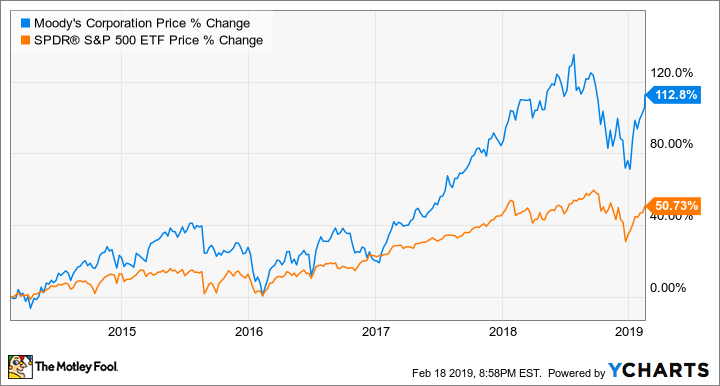If you were to design the world's most boring company from the ground up, you would be hard-pressed to beat Moody's (MCO -0.25%).
Moody's consists of two primary business segments. The first, Moody's Investors Service (MIS), provides credit ratings to corporate and government bonds, banks, and various fixed-income funds (Moody's is known as one of the "Big Three" in the credit ratings business, the other two being S&P Global (NYSE: SPGI) and Fitch Ratings). The second segment, Moody's Analytics (MA), provides financial research, analytics, and consultation services. Nothing exciting, just a financial services company that provides valued services to its customers.
Yet Moody's has been nothing but exciting as an investment. While the stock is trading about where it was a year ago, essentially keeping pace with the broader S&P 500 index, Moody's shares have more than doubled the index's returns over the trailing 3-, 5-, and 10-year periods.
When the company reported its fourth-quarter earnings earlier this month, the results were mixed. Revenue shrank to $1.06 billion, a 9% decrease year over year, while adjusted earnings per share (EPS) rose to $1.63, an 8% increase year over year. Nothing about those results particularly sings, but we haven't gotten to the exciting part. The company's full-year adjusted operating margin was 47.7%, a sky-high margin rarely matched by any business model. The company produces such large margins on the back of its MIS business and the two distinct and wide economic moats it enjoys.
Sustainable competitive advantages
The MIS business segment sported a 58.4% adjusted operating margin in 2018. It can support such juicy profits because of the dominant competitive advantage it enjoys in the debt-rating business. First, nearly all developed economies support strict regulatory approval for companies to operate as credit rating agencies. In the United States, the Securities and Exchange Commission recognizes 10 such companies; in Europe, there are 26 accredited organizations. This regulatory hurdle is a major obstacle to any start-ups that might try to disrupt the space.

The credit ratings agency business is extremely lucrative, as Moody's Corporation shareholders know all too well. Image source: Getty Images.
Second, Moody's enjoys an intangible advantage from its brand. The Big Three dominate the market due to their easy name recognition, reputation, and history of operating in the industry. That translates into a more than 90% collective market share in the U.S. and Europe for the trio. This oligopoly allows Moody's to annually raise prices by about 3% to 4%, which, over time, leads to the high margins noted above.
Unfortunately, while the debt-rating business leads to high margins, it is not always conducive to growth or reinvestment opportunities. Indeed, MIS is often tied to macroeconomic factors far outside the company's control, which can lead to uneven results from quarter to quarter. It is this inconsistency that led to the fourth-quarter revenue decline. During the company's conference call, management called out a 30% drop in global debt issuance weakness that led to the segment's weakness.
Reinvestment opportunities
While the company cannot always reinvest for growth in its credit-rating business, it does have its data analytics and research segment that allows it to grow. While MA does produce lower margins than MIS, it is not a "low-margin" business. In the fourth quarter, MA's revenue grew 5% on 27.3% adjusted operating margins. Revenue growth was slower than normal thanks to a shift from selling software based on licensing to a recurring, software-as-a-service (SaaS) business model.
Moody Analytics also looks for acquisition opportunities to boost revenue. In 2017, this led it to acquire Bureau Van Dijk, a company that distributes intelligence and data about private companies from around the world. Last year, Moody's acquired Reis, a commercial real estate data company. These types of data companies can be easily integrated into Moody's own analytics company while being accretive to earnings and providing it with a more holistic service. During the conference call, CEO Raymond McDaniel commented on how the Reis acquisition meets these criteria:
Our recent acquisition of Reis, which closed on October 15th, 2018, is a good example of expansion into an adjacent product area. Reis, a leading provider of U.S. commercial real estate or CRE data has built a unique data set over 40 years. We have observed growing demand from our asset management banking and insurance customers for a reliable source of integrated information and analytics to support management of their substantial exposures to CRE. By combining Reis' proprietary data with MA's specialized expertise, Moody's is powerfully positioned to meet the need for standards that enhance operational efficiency and analytical precision in this market.
Check out the latest Moody's earnings call transcript.
Final thoughts
Based on the company's full-year 2019 guidance, management expects revenue to grow about 6% to 10%. Based on the midpoint of this guidance, Moody's forward P/E ratio is 21.2. For a company that commands pricing power and high profit margins, possesses competitive advantages and reinvestment opportunities, this seems to be a strong buy. It is for these exact reasons I added shares of Moody's to my own portfolio earlier this year.






